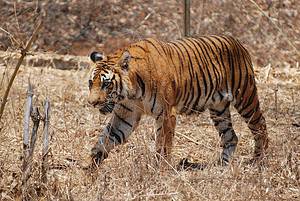Tigers and mountain lions are both large cats and natural predators. While the tiger is largely native to the Eastern Hemisphere, the mountain lion is found in the Western Hemisphere. Therefore, it is unlikely that the two predators would ever cross paths. If they did happen to meet, though, and engage in a fight, it would be fascinating to see who might win. Discover which large cat would win in an epic battle and why.
Background on Tigers

Tigers thrive best in grasslands and deciduous forests. Unlike dense rainforests, these habitats have a greater number of prey.
©iStock.com/Ondrej Prosicky
Tigers are one of the largest big cat species in the world. They are native to Asia, including countries like China, India, North Korea, and Eastern Russia. These creatures adapt well to their surroundings. For instance, some tiger species can survive in temperatures that reach -40ºF. On the other hand, there are tigers that live in warmer climates with temperatures that exceed 100ºF. Tiger habitats include anything from taiga to grasslands to rainforests. In some cases, tigers can be encountered walking near ancient ruins.
Tigers thrive best in grasslands and deciduous forests. Unlike dense rainforests, these habitats have a greater number of prey. Furthermore, these mammals do not enjoy intense heat. Therefore, tigers will often swim in rivers and other bodies of water to escape the sun and humidity.
The term “tiger” encompasses a variety of species. For instance, the Siberian tiger is the largest species, which can grow up to 13 feet long and reach a weight of 660 pounds. The Bengal tiger is one of the most well-known species because it has the largest population. In fact, half of all tigers in the world are Bengal tigers. These large kitties record a maximum length of 7.2 feet. The species weighs between 350 and 500 pounds, and southern Bengal tigers are typically smaller than northern Bengal tigers.
Other tiger species, like the Indo-Chinese tiger and Sumatran tiger, have a different coloration than a typical orange tiger with black stripes. Instead, these mammals have a reddish tan coat with very dark stripes. Interestingly, white tigers, many of which are albino, can be encountered in India. Black tigers are a rare find, but they have been seen in forests in Bangladesh, India, and Myanmar.
How Tigers Eat
Tigers are carnivores, meaning they only eat meat. The diet of a tiger includes a diverse assortment of prey, like deer, wild pigs, porcupines, and some livestock. In some instances, although rare, tigers may attack large mammals like water buffalo and elephants. Hunting skills for this animal are a result of both nature and nurture. How to hunt and capture prey is taught to young tigers by their mothers.
Tigers are at the top of the food chain, which allows them to control prey population in the wild. Tiger presence in the wild ensures that populations of smaller animals do not grow too large, as such an increase would heighten competition among animals and possibly cause extinction of some species. Some tigers will attack and eat humans, but this only occurs in specific parts of the world. Places where man-eating tigers exist include northeast India, Royal Chitwan National Park, and the Sundarbans.
Dangers of Tigers
Tigers are expert hunters and can pose many threats to other animals and humans. Typically, tigers will not attack humans unless threatened. If a tiger feels that their cubs are in danger or that their territory is being intruded upon, they might attack an animal or human. Furthermore, tigers that are kept in captivity, like in zoos or circuses, are likely to show greater aggression than those in the wild. Increased aggression in captive tigers is due to their inability to practice their innate hunting skills or predatory behavior in nature. Overall, tigers avoid human contact.
Tiger aggression is typically a result of self-defense. And if a tiger is unable to hunt for common prey for reasons such as age or injury, the mammal might resort to attacking something outside of its typical diet. Tigers have very sharp claws and strong bodies, which make them both an apex predator and a formidable creature. A tiger bite has the force of approximately 1,050 psi, which is twice as strong as that of a lion. Therefore, tigers can easily devour prey and even humans.
Background on Mountain Lions

The South American
mountain lion
resides primarily in the Southern Hemisphere in countries like Peru or Venezuela.
©Evgeniyqw/Shutterstock.com
Mountain lions go by many common names, such as cougars, pumas, and even panthers. These large cats reside in the Western Hemisphere, and they maintain the largest distribution of any other mammal in this hemisphere. In fact, mountain lions can be found anywhere between lower Alaska and Argentina in South America. Habitats of mountain lions include swamps, forests, and deserts with some vegetation.
Mountain lions in North America record an average weight of 136 pounds and an average length of four feet. Females are typically shorter and weigh less than male mountain lions. However, mountain lions that live near the Equator are smaller than their northern or southern counterparts. Coloration of the mountain lion’s coat is usually brown or light brown. Although, some mountain lions can have reddish-brown or gray coats, depending on the region.
The mountain lion also has six subspecies attached to its classification. The main subspecies of mountain lion are categorized by continent. For instance, the two main subspecies are the South American mountain lion and the North American mountain lion. The South American mountain lion resides primarily in the Southern Hemisphere in countries like Peru or Venezuela. On the other hand, the North American mountain lion can be encountered in Mexico, the United States, and Canada.
How the Mountain Lion Eats
Prey of the mountain lion includes ungulates, which is a term that describes any hoofed mammal. One example of hoofed mammals that a mountain lion might attack and consume is deer. Other prey includes smaller mammals like coyotes, beavers, skunks, and even other mountain lions. Like the tiger, mountain lions might also attack livestock on occasion.
Mountain lions typically hunt at night, sunrise, or sunset, which are all times when these animals are most active. In most cases, a mountain lion will travel six miles every evening searching for prey. When mountain lions hunt, they stalk, wait, and hide before pouncing on prey. Mountain lions employ these tactics because their prey is usually faster than they are. Therefore, the mountain lion must stay hidden and use a covert strategy to surprise its prey upon attack.
Dangers of Mountain Lions
Mountain lions can be dangerous animals, as they can attack and kill mammals larger than themselves. In fact, some cases of mountain lion attacks on humans have been reported in the Western United States. Luckily, many humans have been able to fend off these cats and escape alive.
The sharp claws and acute hunting skills of mountain lions make them a threatening predator. Furthermore, they have a bite force of around 400 psi. Although their bite force is not as strong as that of the tiger’s, it is enough to kill humans and animals. The greatest asset that mountain lions have in killing prey, though, is the element of surprise. A mountain lion’s ability to conceal itself and then pounce on a subject makes the species more dangerous.
Tiger vs. Mountain Lion: Who Would Win in a Fight?
In a battle between a tiger and a mountain lion, the tiger would likely win. The tiger would come out victorious for several reasons. First, most tiger species are significantly larger than the average, or even the largest, mountain lion. The tiger’s massive size allows it more strength over the mountain lion.
Furthermore, tiger claws are typically larger than mountain lion claws. For instance, the Siberian tiger has claws that are nearly twice the size of those of the mountain lion. Tigers also have a more powerful bite force than a mountain lion. With a bite force of 400 psi, the mountain lion is no match for the 1,050-psi bite force of a tiger. In this epic battle, it’s clear that the tiger would take down the mountain lion and emerge victorious!
The photo featured at the top of this post is ©
FAQs (Frequently Asked Questions)
Who would win in a fight: tiger vs. mountain lion?
A tiger would win in a fight against a mountain lion due to its strength, claw size, and bite force.
Where are mountain lions located?
Mountain lions live in the Western Hemisphere between southern Alaska and Argentina.
Do man-eating tigers exist?
Some tigers do eat humans, but they are only present in a few specific locations on Earth.
Thank you for reading! Have some feedback for us? Contact the AZ Animals editorial team.






